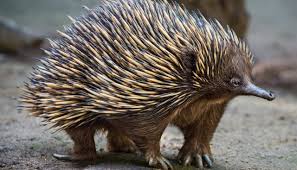
Echidna
Type: mammal
Length: 76 cm
Weight: 10 kg
Lifespan: 50 years
Diet: insects
Description: Echidnas, also called spiny anteaters, are walking contradictions. They are mammals, but they lay eggs. They are often classified as long- or sort-beaked, but don't have beaks at all, in the traditional sense; they have fleshy noses that can be either on the long side or rather short. They don't really look like true anteaters (Myrmecophaga tridactyla), either, and they are not closely related to them. They are spiny, though; their bodies are covered with hollow, barbless quills. Echidnas are monotremes, egg-laying mammals. The only other living monotreme is the platypus. The short-beaked echidna (Tachyglossus aculeatus), also called the short-nosed echidna, is one of four living species of echidna, and the only member of the genus Tachyglossus. It is covered in fur and spines and has a distinctive snout and a specialised tongue, which it uses to catch its insect prey at a great speed. Like the other extant monotremes, the short-beaked echidna lays eggs; the monotremes are the only living group of mammals to do so. The short-beaked echidna has extremely strong front limbs and claws, which allow it to burrow quickly with great power. As it needs to be able to survive underground, it has a significant tolerance to high levels of carbon dioxide and low levels of oxygen. It has no weapons or fighting ability but deters predators by curling into a ball and protecting itself with its spines. It cannot sweat or deal well with heat, so it tends to avoid daytime activity in hot weather. It can swim if needed. The snout has mechanoreceptors and electroreceptors that help the echidna to detect its surroundings.
Found in: Throughout Australia